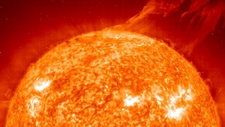Sun: Physical Characteristics
Supporting

TEKS Objective
The student is expected to identify and compare the physical characteristics of the Sun, Earth, and Moon.
Essential Understanding
The student knows that there are recognizable patterns in the natural world and among the Sun, Earth and Moon system.
Science Background
The Sun: The Nine Planets (website) - Brief description of the Sun and its properties.
The Sun
Nine Planets, http://www.nineplanets.org
Solar System Exploration: NASA (website) - Information, pictures, and news about the Sun and solar system.
Solar System Exploration
NASA, http://www.nasa.gov
Characteristics of Our Sun: School for Champions (website) - This site presents an explanation of the Characteristics of our Sun by Ron Kurtus - Succeed in Understanding Astronomy.
Characteristics of Our Sun
School for Champions , http://www.school-for-champions.com/
Signature Lesson
The Science of the Sun: NASA Solar Dynamics Observatory (PDF) - The “Size of Things” lesson (p. 33) helps students to understand that the Sun is the largest object in our solar system.
The Science of the Sun
NASA Solar Dynamics Observatory, sdo.gsfc.nasa.gov
- Supporting Lessons
- Extensions
- Assessment Ideas
- Literature Connections
- Related
TEKS - Additional Resources
Supporting Lessons
The Sun: Science NetLinks (website) – This lesson will introduce students to our local star, the Sun, especially its structure and its features such as sun spots, magnetic fields, and solar flares.
Elaboration Lessons and Extensions
Our Star the Sun: Project First (website) - This collection of activities teaches students about the Sun, day and night, shadows, motion of the Sun and Earth, etc.
Our Star the Sun
Project First, Eye on the Sky, www.eyeonthesky.org
Sun As A Star: NASA (website) - Downloadable collection of activities from NASA and the American Museum of Natural History about the properties and benefits of the Sun.
Assessment Ideas
Ask students to write a paragraph explaining what the Sun is and how it is different from the Moon and planets of the solar system.
Literature Connections
The Sun. Simon S. (ISBN: 978-0688092368)
Experiments with the sun and the Moon, Tocci, Salvatore (ISBN: 0-516-22605-3)
Sun, Meachen-Rau, Dana (ISBN: 0-756-50440-6)
Sun, Pipe, Jim (ISBN: 1-932-79946-X)
Sun, Burgeois, Paulette (ISBN: 1-550-74330-9)
Sun, Kerrod, Robin, (ISBN: 0-822-53901-2)
The Sun, Winrich, Ralph (ISBN: 978-1-4296-0721-6)
Additional Resources
Solar and Heliospheric Observatory: European Space Agency and NASA (website) - Extensive catalog of downloadable images and videos of the Sun.
Solar and Heliospheric Observatory
European Space Agency and NASA, sohowww.nascom.nasa.gov
Solar Events: Yohkoh Public Outreach Project (website) - Images and videos of the Sun, produced by an X-ray telescope on board the Yohkoh satellite.
Solar Events
Yohkoh Public Outreach Project, Lockheed Martin Corporation, www.lmsal.com
What’s Up in Space: SpaceWeather.com (website) - This site tracks solar activities and their effects on the near-space environment of Earth.
TEKS Navigation
Grade 5
Need Assistance?
If you need help or have a question please use the links below to help resolve your problem.

Comments